Why should I supplement my horse with the ingredients in Neigh-Lox Advanced?
The ingredients in Neigh-Lox Advanced help maintain a healthy digestive tract in horses that are consuming high-grain diets, are under stress, or prone to digestive health issues. These ingredients support a healthy digestive tract by maintaining normal pH levels throughout the tract, sustaining healthy tissues, and nourishing a healthy microbiome. When horses’ digestive tracts are healthy they utilize their feed more efficiently, have an normal appetite, a healthy immune response.
What is Saccharomyces boulardii ?
Saccharomyces boulardii is a yeast related to the more common Saccharomyces cerevisiae however, it contributes some very different and supportive functions to the horse’s GI tract. It has been research proven to convey specific nutrients to the lining of the small and large intestines that maintain and support the growth of healthy tissues. Unlike other yeasts, lyophilized S. boulardii is a living organism that remains viable after transit through the gastric environment.
It is important to remember that continual administration is key to the maintenance of healthy gut operations. Lyophilized S. boulardii is viable (alive) and active, but it is also short-lived in the digestive tract. So while it supports multiple immunostimulatory benefits, it does not multiply itself or reside within the tract beyond 3 to 5 days. Therefore, it should be supplemented at least daily in order to realize all the benefits of maintaining a healthy digestive tract.
For those horses consuming higher quantities of grain, research has demonstrated that oral administration of the lyophilized yeast results in a stimulation of several brush border membrane enzymes. This supports a more complete digestion of nonstructural carbohydrate (NSC) feedstuffs—starches and sugars—in the foregut, thereby decreasing the amount of NSC that may escape to be fermented in the hindgut. Supporting increased digestibility of NSC feedstuffs can decrease the risk digestive health issues.
Very recent research focuses on the mode of action by which S. boulardii supports the normal functionality of and healing of damaged intestinal lining and enteroluminal spaces. Researchers concluded that ingested S. boulardii secretes factors while moving through the gastrointestinal tract that are pro “motogenic.” That means it supports the movement of intestinal cells in repairing damaged cells in the gut epithelium.
What are fermentation metabolites and how do they support a horse’s healthy digestive tract?
Fermentation metabolites (FM) are produced from a proprietary yeast fermentation process. These FM support a healthy immune balance of the horse’s gastrointestinal system. A few of the nutritional metabolites in FM include polyphenols, nucleotides, and phytosterols.
These metabolites have been shown in controlled research trials to support a normal, healthy immune response when the body is faced with a challenge.
FM has also been shown to support healthy antioxidant status. Normal antioxidant levels support healthy muscle and respiratory recovery after exercise.
In addition to directly supporting the horse’s own immune responses and antioxidant status, FM support the growth and activity of bacteria in the hindgut and throughout the GI tract. FM helps to maintain functional microbes throughout the digestive tract.
What is the difference between the original Neigh-Lox and Neigh-Lox Advanced?
The original Neigh-Lox was developed to maintain normal gastric acid levels and a healthy mucosal lining in the stomach. By maintaining healthy environment in the stomach your horse’s risk of developing imbalances is greatly reduced.
Neigh-Lox Advanced combined the ingredients found in the original Neigh-Lox with a proprietary blend of fermentation solubles and Saccharomyces boulardii (a yeast). These ingredients work synergistically to support both a healthy foregut and hindgut.
Will Neigh-Lox Advanced cure stomach ulcers in horses?
No, Neigh-lox is not a drug and will not cure ulcers.
Neigh-Lox Advanced is a supplement that contains a proprietary combination of ingredients designed to support normal acid levels in the stomach. Neigh-Lox Advanced is an affordable way to maintain a healthy stomach. Neigh-Lox Advanced is an appropriate digestive supplement to use following a course of omeprazole to maintain normal tissues. Additionally, Neigh-Lox Advanced provides fermentation metabolites and S. boulardii that support a healthy hindgut, as well as maintain a normal immune system.
Why do today’s horses have so much trouble with their digestive systems?
The simplest explanation for the challenges our horses’ gastrointestinal tracts face is, in a word, “man.” In the wild the horse is intended to be a nomadic browser. They are herbivores (plant eaters) that can meet their energy requirements solely from the grass leaves, stems and seeds found in the slopes, basins, and prairies of most of the continents. They not only survive but flourish on relatively low-quality forages. The horse’s cecum provides an optimum environment for billions of bacteria to ferment these structural carbohydrates and extract sufficient nutrients and calories from which the horse can reproduce, grow, escape prey at a gallop, and travel great distances in search of food, water, and mates. How then does man create problems for the horse’s GI tract? We “kill them with kindness,” in a manner of speaking.
Once bound to wander far and reap what little nature had sown across water-starved prairies or snow-covered steppes, the horse now has practically unlimited sources of energy and nutrients thanks to man. We’ve cleared forests for their lush pasture; we’ve mixed grains in their energy-dense meals; we’ve even harvested their forages to optimize nutrition during those lean winter months and built shelters to protect them from the elements. Put together, it sounds as though we’ve done much good for the horse; however, for all our “help” we’ve created many problems. By not accounting for the naturally evolved processes that still occur in the domesticated horse’s gut we have made the horse susceptible digestive health issues. Just because our horse’s behavior is domesticated doesn’t mean his digestive tract is.
What is fiber?
Fiber, sometimes referred to as slowly fermentable carbohydrates or structural carbohydrates, includes hemicellulose and cellulose. Hemicellulose and cellulose are found in the hard, rigid stems of plants and are also present in leaves. Fiber is responsible for the rigid, upright structure of plants. These carbs have a complex molecular structure that cannot be digested and broken down by gastric acids or enzymes in the foregut (stomach and small intestine). Instead, they are fermented in the hindgut by the resident microbes. Because of the complex structure of these carbohydrates, more time is required for the microbes to completely break them down, hence the name “slowly fermentable carbohydrates.”
Where do horses get most of the fiber in their diet?
Pasture and hay are the major sources of fiber. The slowly fermentable carbohydrates, or fiber, content increases as the pasture plants mature. In pasture, maturity can be determined by plant height and presence of a seed head. The taller the pasture, the more mature it is. When the pasture has seed heads, it is at its most mature stage. Hay cut at a later stage of maturity is more fibrous than hay cut in early stages of growth. Grasses (e.g., orchardgrass) tend to be more fibrous than legumes (e.g., alfalfa), which can be largely attributed to the different physical traits of grasses and legumes. Grasses generally have long, slender leaves that require more structural support, whereas legumes have rounder, broader leaves easily supported by the stem.
Why is fiber so important in my horse’s diet?
Diets too low in fiber can lead to serious health problems in horses. Horses receive most of their daily forage in the form of pasture and/or hay. Insufficient fiber in your horse’s diet can cause hindgut acidosis (too much acidity), gastric ulcers (due to lack of buffering from saliva production), and/or increased risk of cribbing, wood-chewing, and behavioral problems. A general guideline recommended by equine nutritionists is to feed 2% of your horse’s body weight in good quality fiber (slowly fermentable carbohydrates), with half of it being long-stemmed fiber. For a 1,000-lb horse, this is 10-20 lbs of forage per day.
What management practices can reduce the chance of digestive disturbances like colic from occurring in my horse?
Incorporating the following management techniques into your routine can greatly reduce the risk of digestive upset.
- Reduce the amount of starch and sugar in your horse’s diet by replacing it with fats and fiber that are healthier for your horse’s hindgut.
- When concentrates (pellets, sweet feeds, plain grains) are required to provide additional calories, feed multiple small meals of 4 lbs or less at each feeding. This will reduce the incidence of “escape” carbs entering the hindgut and causing acidosis (too much acid in the hindgut).
- Feed good quality free-choice long-stem hay so your horse has an adequate fiber supply to support a healthy microbial population in his digestive tract.
- Keep a consistent feeding schedule, even if that schedule is consistently inconsistent! When a horse is fed late, the sensitive bacteria in the hindgut begin to die off. If enough expire, the hindgut will become unbalanced and toxic. Late feedings stress some horses and others will bolt their meal when fed late. Both instances can lead to digestive upset.
- Be sure your horse always has access to clean water. Horses need to consume 10 to 12 gallons of water a day when hanging out in the stall or pasture; more when exercised. Lack of water causes the food in the digestive tract to move slower and even become impacted.
- Support the microbial population in the digestive tract by providing additional prebiotics and probiotics, especially to horses that are on high-grain diets, exercising hard, traveling frequently, or have a history of digestive upset.
Why is it bad to feed one or two large meals per day to my horse?
One example of what we do to confound our horse’s digestion process is meal-feeding. The horse’s relatively small stomach secretes acid continuously. However, the horse only secretes saliva while chewing. Saliva is highly buffered and naturally acts to counterbalance the acid produced in the stomach. This makes sense when we take into consideration that a horse is intended to be continually browsing food for up to 20 hours per day. When the horse is confined to a stall or dry-lot, and meal-fed two to three times per day, his digestive system does not alter to accommodate the eating schedule humans impose on it. In such cases the horse may not be eating for hours at a time, yet all the while his stomach continues to produce acid. In addition there is little saliva being produced that could counteract the acidic stomach because the horse is not chewing. Therefore, in between meals of hay and grain, your horse’s system works against him. The resulting buildup of acid increases the risk and occurrence of gastric ulcers.
Nutritionists recommend feeding no more than 4 lbs of grain per meal. If your horse requires grain to maintain body condition, consider splitting the grain ration into several small meals throughout the day.
Feeding diets high in starch and sugar:
Another digestive malady facing many horses, in particular hard-working athletes or those that need additional calories to meet their energy requirements, is acute and/or chronic acidosis. This is a condition in which the pH (acid/base) level in the hindgut is too low or two acidic. This problem ultimately results from over-feeding of grains in the form of pellets, sweet feeds, or even plain grains such as oats. These feedstuffs are high in sugar and starch, also known as nonstructural carbohydrates or NSC. However, because the horse’s GI tract is designed to consume small bits of grains with lots of forage, the gastric enzymes produced for starch and sugar digestion are insufficient to fully, or even mostly, digest significant amounts of grains in the stomach and small intestine. Therefore, when large meals of grain-based feedstuffs are given, considerable amounts of readily fermentable starch and NSC escape digestion in the gastric/foregut region and arrive ready for rapid fermentation in the bacteria-dense hindgut segment. This can cause big problems for your horse.
As the bacteria ferment the escaped (or pass through) NSC, a build-up of acids from fermentation cause the pH in the hindgut to drop drastically. As a result of low pH (high acid) a cascade of harmful events begins to unfold. There is a decrease in activity and numbers of fiber-digesting bacteria and an increase in acid-producing bacteria, resulting in the production of relatively strong acids such as lactic acid. These acids damage the epithelial tissue lining the walls of the cecum and colon. The damage results in a decreased absorptive functionality of the tissue, inflammation, and pain. This can lead to digestive upset and colic. At the same time the mass die off, certain bacteria release endotoxins (poisonous substances) into the horse’s system. These endotoxins can lead to decreased blood flow to the hooves and significantly increase the risk of laminitis (founder).

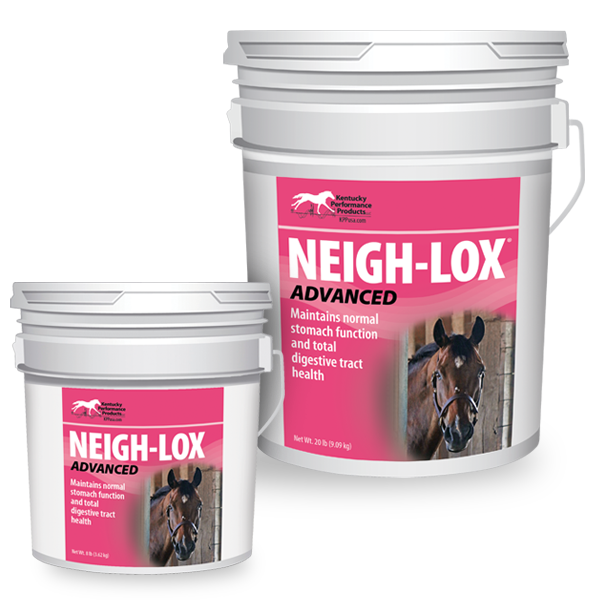

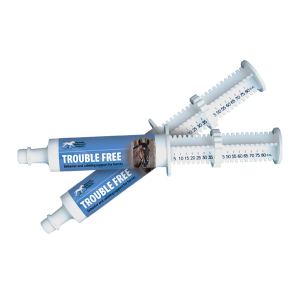
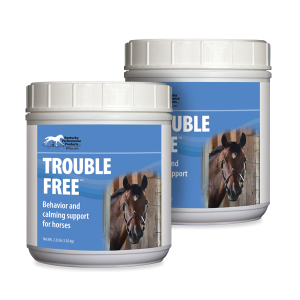
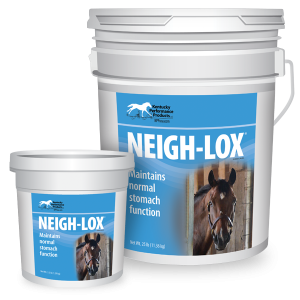
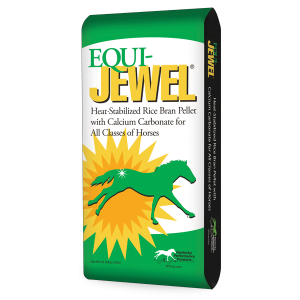

Kim Baierl –
Our vet recommended Elevate for both horses to maintain a strong immune system. In talking with Lisa Barry a 5* Eventer, she recommended Tage receive digestive support with Neigh-Lox Advanced.
Each horse gets a blue scoop of Elevate in AM and PM food. Additionally Tage gets 2 scoops of Neigh-Lox Advanced AM and PM.
Both products are easy to administer and eaten happily.
Dominique Lien –
“When I got my OTTB Blue, transitioning her diet was one of my biggest challenges. She was the definition of a hard keeper. It wasn’t until I started working with Kentucky Performance Products staff that we were able to fill in the holes in her diet and the changes were phenomenal. I trust KPP to help me with all of Blue’s nutritional needs.
Dominique Lien
Retired Racehorse Project participant and Thoroughbred Makeover competitor
Lexington, KY